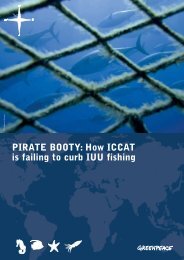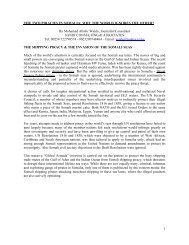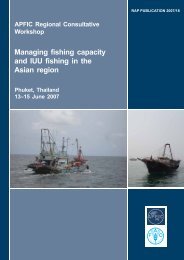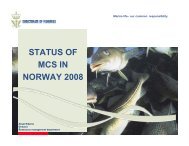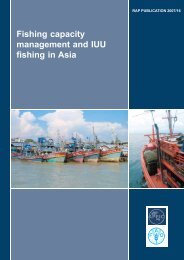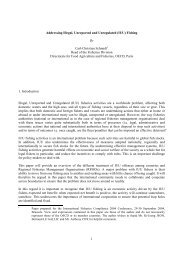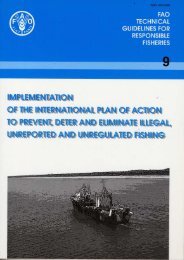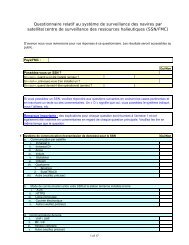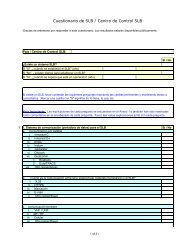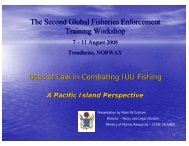Fishing Vessel Monitoring Systems: Past, Present and Future
Fishing Vessel Monitoring Systems: Past, Present and Future
Fishing Vessel Monitoring Systems: Past, Present and Future
Create successful ePaper yourself
Turn your PDF publications into a flip-book with our unique Google optimized e-Paper software.
VMS: <strong>Past</strong>, <strong>Present</strong> <strong>and</strong> <strong>Future</strong> 7<br />
It is interesting that, until now, though the technology exists <strong>and</strong> can be easily<br />
implemented, there are very few examples of such operational systems.<br />
Examples would include Icel<strong>and</strong> <strong>and</strong> Norway <strong>and</strong>, to a lesser extent, regional<br />
fisheries management authorities, such as the Northwest Atlantic Fisheries<br />
Organization (NAFO), the Northeast Atlantic Fisheries Commission <strong>and</strong> the<br />
Forum Fisheries Agency of the South Pacific. The principal difference between<br />
the two Nordic countries <strong>and</strong> the mentioned RFMOs is that the former provide<br />
their data using fully electronic forms, to that it is entered automatically <strong>and</strong><br />
immediately in the receiving authority’s database. The latter use electronic<br />
means of transmitting their data (e.g. satellite telephone or data systems) but<br />
without the use of electronic forms. Whilst this speeds delivery of the data to the<br />
authority, there remains a manual step required to enter it in the database.<br />
It should be noted that, despite the existence of the technology, there is probably<br />
a very strong political reason that full electronic catch reporting from sea has<br />
been slow to be implemented: that the collation of real-time electronic catch data<br />
<strong>and</strong> VMS data is a highly sensitive point so far as the fishing industry is<br />
concerned. <strong>Vessel</strong> operators, correctly, consider this data to be commercially<br />
confidential. Until a means can be devised to assure them that this data will be<br />
completely safe from their competitors, they will resist its implementation.<br />
Resolving some of these concerns is within the brief of the European<br />
Commission’s SHEEL (Secure <strong>and</strong> Harmonised Electronic European Logbook)<br />
research project, scheduled for completion in 2006.<br />
The SHEEL project estimates that the operation cost of a detailed catch report<br />
would be somewhere between less that $1 <strong>and</strong> $5 per report, depending upon<br />
the size of the report <strong>and</strong> the transmission medium used. Putting a catch report<br />
into place would require investment equal to a laptop computer as user terminal<br />
<strong>and</strong> the necessary software to manage the electronic logbook. It is far more<br />
difficult to define this last costl<br />
2.0 State of the art<br />
It is impossible to discuss the use of satellite navigation <strong>and</strong> communications<br />
systems <strong>and</strong> their role in fishing vessel monitoring without a shared<br />
underst<strong>and</strong>ing of exactly what is a VMS. It is often assumed that VMS is a<br />
synonym for satellite surveillance. This is not accurate.<br />
At the current state of the art VMS is a “cooperative” system where only<br />
participating vessels are monitored. It is a “cooperative” system because each<br />
participating vessel must carry an operating transmitter or transceiver<br />
(sometimes incorrectly referred to as a transponder, which is capable of fixing a<br />
position, (in most cases, calculating its own position <strong>and</strong> thus the position of the<br />
boat carrying it). An automated reporting system then controls the transmission



